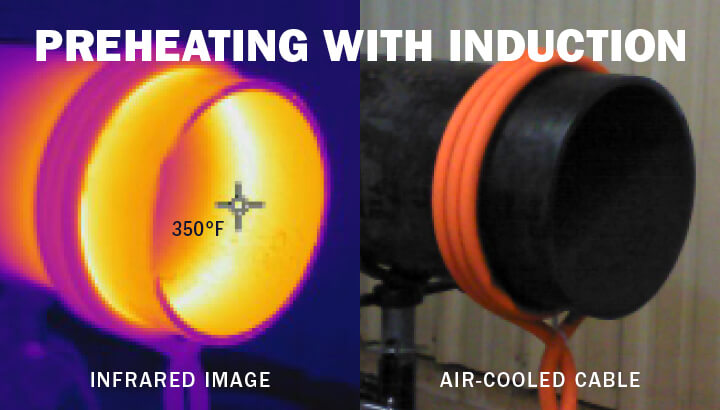
Welding preheating is used to ensure weld quality and reduce the chance of cracking and other defects that can result in costly rework. Preheating is commonly used in field and shop applications when welding steel or steel alloy pipes or plates that are 1” thick or more. Applications that often use preheating include power plant and structural construction, as well as pipe fabrication. Here, Miller Electric outlines four common methods for welding preheating and how to choose the best option for your application.
When To Use Preheating
The process of preheating involves heating the area around the weld joint or the entire part to a specified temperature before welding. This reduces the weld cooling rate and drives out moisture, which helps prevent hydrogen buildup and the potential for cracking.
Determining whether an application requires preheating depends on several factors, including the type and thickness of the base material. Often, use of preheating is dictated by the welding procedure specification (WPS), which outlines the minimum and maximum preheating temperatures as well as the necessary duration of preheating. Welders typically must monitor and document the base material temperature between weld passes to ensure the metal remains within the required temperature range.
Weld Preheating Methods
Several methods can be used for preheating, and each option offers benefits and drawbacks. Determining the best method for a specific application often depends on the material thickness, weldment size, project timeline and budget, and available personnel and expertise.
- Induction creates a magnetic field that generates eddy currents within the base metal, heating it internally from within. Accessories such as cables or blankets are placed on or near the part to generate the magnetic field. Induction provides quick setup time—often less than five minutes—and a fast time to reach the desired temperature. This method also produces a uniform heating area, making it easy to achieve and stay within the necessary temperature window. In addition, because the output coils do not get hot or create an uncomfortably hot environment for welders, induction can be safer than other methods. It also delivers flexibility to heat parts of many sizes and shapes. Induction can have a higher initial cost and require some operator training to ensure proper wrapping techniques.
- Open flame involves operators using a fuel gas and compressed air torch (sometimes called rosebuds) to apply flame directly to the metal part. Flame preheating requires little operator training, but it does have several drawbacks. Flame often provides inconsistent temperature uniformity, has a slower time to reach desired temperature because of its inefficient process, and also compromises comfort and safety for operators working near the soot, smoke, and gases produced. This method also includes the extra expense of gas storage and distribution.
- Resistance heating uses electrically heated ceramic pads placed on the base metal. The tiles transfer heat to the part through radiant and conductive heat, specifically where the pads are in contact with the part. This method can offer temperature consistency as long as no heating pads are broken. Downsides of resistance heating include cost and inefficiency. This method is often contracted out to a third party, increasing the cost. It can also sometimes take an hour or more to arrange and secure the heating pads on the part; the required cool-down time also adds significant time to the process. Broken heating pads can cause hot and cold spots in the part and add repair and replacement costs to your heating process. Also, resistance heating elements get extremely hot and can pose a safety hazard.
- Ovens use convection heating, and the entire part is placed inside the oven, resulting in uniform heating. This method allows for heating many parts at once. However, ovens can be quite large and must be connected to an electrical outlet or gas supply, so they lack mobility. When large parts are involved, you may have to transport hot parts through your facility. In addition, the oven may need to be preheated for several hours before it is used, adding time to the process.
Induction Provides Many Benefits
Many critical welding applications require preheating. Understanding the differences between the preheating methods can help you choose the one that optimizes efficiency, reduces costs, and minimizes safety hazards for operators. Contractors in numerous industries have seen significant time savings with a move to induction heating—reducing cycle time by several hours per weld in some cases. Compared with other methods, induction heating is an efficient, consistent method for preheating, bakeout, and stress relieving for a wide range of part shapes and welding applications, helping you save time and money.
For more information, visit www.millerwelds.com.


